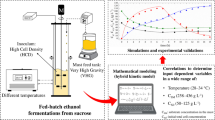Abstract
A data-driven model is presented that can serve two important purposes. First, the specific growth rate and the specific product formation rate are determined as a function of time and thus the dependency of the specific product formation rate from the specific biomass growth rate. The results appear in form of trained artificial neural networks from which concrete values can easily be computed. The second purpose is using these results for online estimation of current values for the most important state variables of the fermentation process. One only needs online data of the total carbon dioxide production rate (tCPR) produced and an initial value x of the biomass, i.e., the size of the inoculum, for model evaluation. Hence, given the inoculum size and online values of tCPR, the model can directly be employed as a softsensor for the actual value of the biomass, the product mass as well as the specific biomass growth rate and the specific product formation rate. In this paper the method is applied to fermentation experiments on the laboratory scale with an E. coli strain producing a recombinant protein that appears in form of inclusion bodies within the cells’ cytoplasm.






Similar content being viewed by others
References
Gnoth S, Jenzsch M, Simutis R, Lübbert A (2006) Product formation kinetics in a recombinant protein production process, CAB-2007, IFAC. Elsevier, Amsterdam (accepted)
Haykin S (1999) Neural networks: a comprehensive foundation, 2nd edn. Prentice Hall, Upper Saddle River
Jenzsch M, Gnoth S, Beck M, Kleinschmidt M, Simutis R, Lübbert A (2006) Open loop control of the biomass concentration within the growth phase of recombinant protein production processes. J Biotechnol 127:84–94
Levisauskas D, Galvanauskas V, Henrich S, Wilhelm K, Volk N, Lübbert A (2003) Model-based optimization of viral capsid protein production in fed-batch culture of recombinant Escherichia coli. Bioprocess Biosyst Eng 25:255–262
Schubert J, Simutis R, Dors M, Havlik I, Lübbert A (1994) Bioprocess optimization and control: application of hybrid modelling. J Biotechnol 35:51–68
Shioya S (1992) Optimization and control in fed-batch bioreactors. Adv Biochem Eng Biotechnol 46:1
Simutis R, Lübbert A (1997) Exploratory analysis of bioprocesses using artificial neural network-based methods. Biotechnol Prog 13(4):479–487
Soons ZITA, Voogt JA, van Straten G, van Boxtel AJB (2006) Constant specific growth rate in fed-batch cultivation of Bordetella pertussis using adaptive control. J Biotechnol 125:252–268
Walsh G (2006) Biopharmaceutical benchmarks 2006. Nat Biotechnol 24(7):769–776
Yoon SK, Kang WK, Park TH (1994) Fed-batch operation of recombinant Escherichia coli containing Trp promoter with controlled specific growth rate. Biotechnol Bioeng 43:995–999
Acknowledgments
The financial support from the “Ministry of Cultural Affairs” of Sachsen-Anhalt, Germany, is gratefully acknowledged.
Author information
Authors and Affiliations
Corresponding author
Rights and permissions
About this article
Cite this article
Gnoth, S., Jenzsch, M., Simutis, R. et al. Product formation kinetics in genetically modified E. coli bacteria: inclusion body formation. Bioprocess Biosyst Eng 31, 41–46 (2008). https://doi.org/10.1007/s00449-007-0161-9
Received:
Accepted:
Published:
Issue Date:
DOI: https://doi.org/10.1007/s00449-007-0161-9




